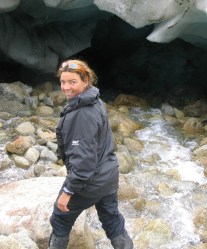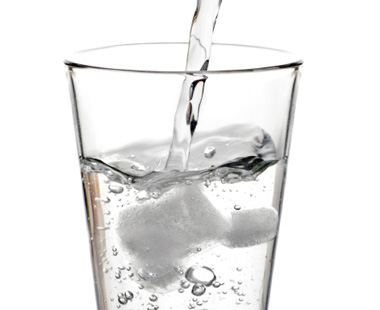
Wendy Pabich at Alaska’s Wrangell-St. Elias National Park.
We need to talk about our national drinking problem. With more than half the country still devastated by drought, and all the experts saying we’d better get used to it, it seems like an appropriate time to discuss water conservation. Problem is, we’re not too great at it: While much of the world lacks this most precious resource on a daily basis, we only need locate the nearest tap to quench our thirst — and some of us still shell out cash to drink from a plastic bottle instead. How can we start to see water like the urgent issue it is?
In her book Taking on Water, Wendy Pabich explains the “diamond-water paradox”: “Although water is more useful than diamonds — in fact, it is essential to life — diamonds command a significantly higher price in the market.” She then quotes Adam Smith: “The things which have the greatest value in use frequently have little or no value in exchange; on the contrary, those which have the greatest value in exchange frequently have little or no value in use.”
Of course, water’s perceived low value has a lot to do with its perceived abundance — and that abundance, as Pabich reminds us, is neither universal nor eternal. Water scarcity is not out of the question for the U.S.: The Ogallala aquifer, upon which nearly a third of irrigated U.S. farmland depends, is being depleted faster than increasingly scarce rainfall can refill it. The story’s similar for many of the world’s most important aquifers.
While chronicling her painstakingly thorough efforts to first measure, and then reduce, her household’s water consumption, Pabich targeted not just her direct use (turning on the tap, flushing the toilet, firing up any number of household appliances) but her overall water footprint — how much water goes into the food she eats, the clothes she wears, and the daily products she uses. She pats herself on the back after calculating that she and her husband each use an average of 154 gallons of water per day, somewhere in between the average daily water use for all Americans (99 gallons) and other residents of Idaho, where they live (263 gallons) — but then cringes remembering that “the average person in Mozambique subsists on slightly more than one gallon of water per day.”
As it turns out, when you take into account all the ways we directly and indirectly guzzle water, our secondhand consumption makes up much more of the total; Pabich found her food alone requires more water to produce than what she uses directly. Which means that your speed showers and rocks in the toilet bowl, while worthwhile efforts, can’t make up for the processes that produce your bread and blue jeans — things that are harder for individuals to control.
Water conservation, like so many other sustainability issues, inevitably begs the question of whether individual actions can have any impact within a larger water-dependent system. Agriculture accounts for 70 to 80 percent of water use in the U.S., and thinking of that as a systemic problem, Pabich says, means “we can put that out of our heads and think that we don’t have much control over it. But when you look at the impact of our aggregate choices, we absolutely have something to do with it.” She points out that it takes 1,500 gallons of water to produce a pound of beef, “and in this country, we are consuming incredible amounts of red meat.”
While it’s a little frightening to see every element of your life as another leaky faucet, the good news is that cutting water use ends up conserving other resources as well. A 2005 study from the California Energy Commission [PDF] determined that “a major portion of the solution [to water and energy insecurity] is closer coordination between the water and energy sectors,” and that water conservation efforts could achieve almost all of the expected savings from an energy-efficiency program, at a little more than half the cost.
But it’s difficult to see saving water as saving money when water is next to free. “If I personally save water in my home, I’m not going to see a big gain [in savings] on my bill,” Pabich says. “The pricing is not enough to really drive behavior.”
If shortages start pushing the value of water in the diamond direction, we had better be prepared — individually and at a policy level — to adjust accordingly. Pabich and her husband already live a sustainable lifestyle relative to many Americans — eating local and low on the food chain, eschewing the car for short trips, shopping at thrift stores. But their irrigated garden accounted for a huge chunk of their household’s water consumption, so Pabich searched for a better way to water the crops.
A simple — and increasingly popular — solution: gray water, the wastewater generated by doing laundry, washing dishes, and bathing, which can be diverted to the yard with a little creative DIY plumbing. Pabich and her husband attached a garden hose to a pipe connected to their washing machine, then watched in awe as one load of laundry caused the hose to spew water for almost nine minutes.
“In a healthy ecosystem, one producer’s waste is another’s food source,” Pabich says. “There’s a tremendous amount of energy and nutrients embedded in our wastewater. So at a minimum we should be trying to harness that as energy.”
In many places (like Idaho), though, gray water stub outs — pipes that can connect to gray water systems — aren’t exactly legal. But communities in the Southwest — where water scarcity is becoming a more urgent issue — are fixing city water codes to make simple water conservation measures easier and more legal. Tucson, Ariz., requires all new residential construction to have gray water stub outs in addition to the original plumbing, and will even reimburse you up to $200 for installing a permanent gray water system. The city also instituted the nation’s first commercial rainwater harvesting ordinance, requiring new commercial construction to meet at least half its landscaping water needs with harvested rainwater.
Surprisingly, typically decadent Las Vegas also stands out. It launched a “cash for grass” program in 2003, paying homeowners up to $2 for every square foot of lawn they ripped up and replaced with drought-tolerant landscaping. The city also uses recycled water in its famous fountains and efficient “tunnel washers” to clean hotel linens.
A 2008 report [PDF] from Western Resource Advocates that looked at the effectiveness of various cities’ water “demand management” programs noted that, given the increasing difficulty and expense of finding new water sources, implementing water-conservation programs, policies, and incentives is a better use of government resources than seeking out new supply. But not all cities have caught on. Pabich talks about a town in her valley that’s “looking at putting in a new well to the tune of a million dollars,” she says. “And they haven’t undertaken a study to understand, what are the alternatives to that? What would it cost to subsidize low-flow toilets in people’s houses [for example]?” No community should underestimate the value of a really good toilet: The University of Washington will save almost $12 million over 25 years as the result of a large-scale toilet replacement program, according to Western Resource Advocates.
Pabich’s methods of using an exhaustive survey of water consumption to measure progress and monitor impact can easily scale to the community level. Local governments, she says, “can take the lead in doing the sort of analysis I did in my house for their community.”
Cities, after all, are perhaps better positioned than any other level of government to lead the way on sustainability. They can make policy changes so citizens and businesses can conserve water without undertaking the Herculean effort Pabich did. As for our indirect water footprint, small lifestyle shifts are important, but Pabich reinforces that it’s our aggregate individual impact that’s the real problem. Remaking our food system, fighting harmful sources of energy (it is called hydrofracking, after all), calling for corporate accountability — these are all battles worth fighting for water’s sake, too.



